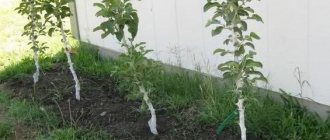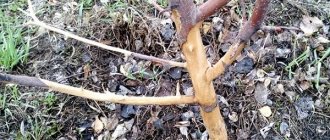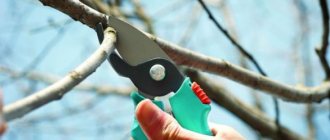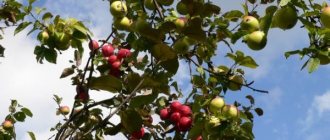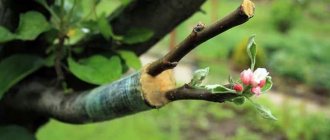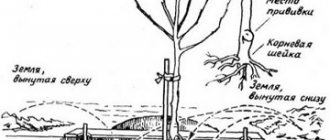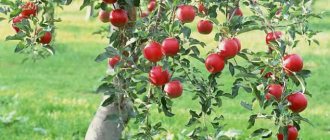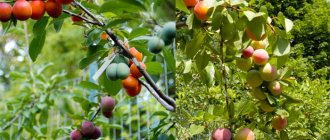Why vaccinate
Every year, gardeners graft fruit trees in spring or autumn. The main purpose of this procedure is the ability to identify new varieties of apples and improve fertility. But that's not all its benefit. There are several more reasons why you need to tie an apple tree before the winter or summer season:
- expanding the range of trees in the garden;
- restoration by tying branches to the stump of a dried or diseased tree;
- the ability to grow several types of varieties on one tree to save space on the site.
There are several reasons why gardeners perform this action. The procedure is quite simple, but after its implementation a positive effect does not always occur. This is due to the assumption of various types of errors. It is important to first study the question of how and when to graft apple trees: in spring or autumn.
Goals and objectives of vaccination
The purpose for which we graft an apple tree in the fall depends on the specific circumstances. Often in our dacha reality one of the situations described below arises:
- we want to have more trees of our favorite variety;
- We don’t have room for a large garden, but we really want to have many varieties of apples;
- there are no seedlings of the variety we want on the market, or we are unsure of the integrity of the seller;
- We are experimenters, lovers of developing new varieties;
- our beloved tree is not feeling well and we want to save it;
- we try to correct the not very beautiful tree crown;
- We are connoisseurs of a wide range;
- there are stumps in the garden that can be grafted onto;
- we want to create an assorted apple tree with different varieties and ripening periods;
- we want to strengthen the winter hardiness of trees and strengthen their immunity;
- The previous vaccination did not work, we want to repeat it.
If the situation occurs, then autumn vaccination can be an excellent solution to the problem, so you should definitely try it.
Normal timing for vaccination
The first thing you need to pay attention to is the timing of vaccination. Gardeners are divided on this point. Some believe that the ideal time for this is spring, while others insist on the need to do this useful procedure in the fall or winter. Regardless of the time of year, it is important to comply with a number of conditions for binding:
- optimal air temperature – up to -15 degrees;
- the minimum period of time before the previous frost is 1 month;
- lack of heat;
- absence of rain at the time of the procedure.
Meeting the deadlines for a favorable connection provides a guarantee of achieving a good result.
In the middle zone of the country with a predominant temperate climate, the optimal period is mid-August - the first half of September. In some regions, for example, in the Moscow region, the air temperature drops later, therefore, vaccination can be done before the first half of October. Important! Before tying an apple tree, it is recommended to study the weather forecast. If frosts are expected in the next 3 weeks, then it is better to leave this procedure for the spring.
When can apple trees be grafted?
Experienced gardeners advocate spring grafting of apple trees. However, many of them note that fruit trees can be grafted not only in spring, but also in autumn, and even in winter, provided that the thermometer drops no lower than -10˚С -15˚С. Whenever you decide to take up this exciting activity, at any time it is important to meet deadlines and be sure to pay great attention to weather conditions.
Grafting an apple tree in the fall does not require a lot of skills and abilities even from novice gardeners. Grafting work in the garden begins in the second half of August - early September. It is very important to have time to complete all work at least a month before the expected frost.
In the northern regions, all work should be completed in mid-to-late September. In the central regions and Moscow region this period is shifted by two weeks. And in the southern regions they do not start grafting apple trees in the fall before the first days of October. They try to finish all work here by early to mid-November.
Before you start gardening, pay attention to weather forecasts. If no frost is expected for the next three to four weeks, then you can begin such an important event. If the forecast is unfavorable, then it is better not to risk it and postpone grafting apple trees until spring.
Interesting! Unripe fruits contain the maximum amount of vitamins.
In what months can an apple tree be grafted in the fall?
Gardeners reasonably argue that the most favorable period for grafting is warm or cool autumn. This is due to the fact that over the winter the plant will grow better and by the new summer season the first fruits of a different variety may already appear. But it is important not to miss the moment. The best time is September. This is especially true for processing mature trees.
October and November are also favorable periods for budding. But, in this case, you should regularly monitor the air temperature; it is important that the thermometer readings do not drop below 15 degrees. In October, it is recommended to graft young trees and seedlings. As a method of tying, for the cool autumn months it is recommended to use the “bark” or “split” method.
Grafting an apple tree for beginner gardeners on a young tree
For grafting on a young tree, two grafting methods are used. This is copulation
and
budding
. Despite the similarity of names, these methods have fundamental differences in the principles of vaccination. It is better to use these vaccination methods in late summer or early autumn, until the average daily temperature drops below 15 °C.
Copulation, simple and improved.
Copulation
is the easiest way to graft an apple tree for beginning gardeners. To graft a scion onto a rootstock using this method, it is enough to make two cuts. On the rootstock, a long oblique cut is made in the direction from the root to the top, and on the scion, the same long cut is made, but in the direction from the crown to the root.
Next, the two sections are joined together so that the cambial layers coincide, and then the junction is wrapped very tightly with either budding tape or cellophane tape.
In order for the graft to take root as best as possible, the cambial layers of the scion and rootstock must match. And the easiest way to achieve this is to use materials of the same diameter.
Improved copulation
it is done in exactly the same way, only in the places of cuts it is necessary to make small longitudinal cuts. It will look like the cut is divided into two approximately equal parts; such cuts must be made on both the scion and the rootstock. And then connect the scion and rootstock using these cuts. We wrap the junction tightly.
Budding apple trees for beginner gardeners
Budding is one of the methods of vegetative propagation of plants, when a bud of an annual shoot of the desired variety is grafted onto a wildflower or apple tree branch. As a result of this, the further development of a full-fledged tree occurs from the grafted bud.
Budding is rightfully considered the simplest and most common method of grafting, firstly, because of its simplicity, and, secondly, because of the high survival rate of the grafted kidney: at least 90-95% if the procedure is performed correctly and in a timely manner. The start and completion times for this vaccination depend on the weather conditions in your area.
The key to the success of budding is the freshness of the scion: the shoots should be as fresh as possible. If for a number of reasons it is impossible to budding immediately after the cut, then the shoots are wrapped in a damp cloth and stored in a cool place. In this case, there are two methods of vaccination: with a shield and in the butt. Shield budding may be a little tricky at first, but don't worry, it's actually a pretty simple method.
For budding, use only very sharp knives.
Budding with a shield.
In order to graft an apple tree using shield budding
, necessary:
On the rootstock branch, in any place you like, you need to make a T
-shaped cut, and then bend the edges at the longitudinal cut so that you get a small pocket.
We cut off a bud from the scion cutting as shown in the photo. And then, we place the cut bud in a pocket on the rootstock branch. Yes, this will require some skill, be careful - try not to cut yourself and not touch the cut areas with your hands.
Once the bud is placed in the pocket, wrap the grafting site tightly with budding tape or plain cellophane tape.
Required tools and materials
Budding is a simple, but still important event. One wrong action can lead to all your efforts being in vain. But it is also possible to harm the tree altogether, which will cause it to dry out and die. The first step in grafting apple trees in the fall is preparing the necessary equipment and materials.
- Knife. It is important that it is sharp and suitable for processing garden land. An ideal option for this purpose is a pruner.
- Insulating tape. Unfortunately, not every summer resident has it. An alternative option is a strip of polyethylene or twine.
- Garden var.
You first need to prepare the rootstock and scion involved in binding. Rootstock is a seedling or small tree to which cuttings or buds are attached. The scion is precisely the cutting that needs to be tied. Of course, you will also need desire, some free time and skills.
Important!
Bacteria or infection can enter the plant through open cuts. It is recommended to first disinfect your hands and all tools that may be required for work with a special solution.
You may be interested in:
The name of apple diseases and how to deal with them The apple is such a common fruit in our country that some gardeners are starting to think about what to grow...Read more...
Optimal season for apple tree grafting: spring or autumn
The period of time in which the gardener decides to make selection plays a decisive role. Action too early or too late can cause the tree to become sick or even die. It is certainly better to do this business in the spring, when all the vital juices of the plant are directed towards creation. But if it was not possible to get vaccinated during this period, you can reschedule it to a later date.
Compliance with deadlines and technology in this case must be strictly observed.
Apple tree grafting in September
Certain selection methods work well in the autumn months. So, for example, in September it is recommended to carry out budding , or to graft “behind the bark”. Also possible:
- copulation;
- cleft;
- semi-split
The timing of work must be selected depending on the growing region, weather conditions and the end of the tree growing season. In September, pinching is practiced in the northern regions, the Urals and Siberia. The work should be completed by the middle of the month.
In October
Autumn grafting is much more difficult than spring or summer grafting. And it must be carried out in a short time. In October, it is appropriate to carry out half-splitting or splitting , as well as copulation.
The procedure should be completed three weeks before the average daily temperature reaches +15 °C. If this condition is met, 95% survival rate of the scion can be achieved. Until the end of October, breeding activities can be carried out in the southern regions of the country.
Scion preparation
The scion, which will be used for grafting onto a seedling or tree, must first be cut into several parts using a sharp knife or pruning shears. This should be done before budding, since they are not subject to long-term storage. The optimal length of the scion is from 25 to 30 cm, thickness - from 1 to 1.3 cm. Another important requirement is the formation of at least 4 healthy buds on it after grafting. Rootstock and scion should only be used from healthy plants.
Split and half split method
It is better to graft apple trees in the fall using these methods. It is advisable that they are no more than 6 years old. On older ones, the vaccination takes root more difficult. With the cleft method, a cut is made along the entire rootstock, this is the difference from half-split. The method is considered universal; it is used both with equal and different diameters of the scion and rootstock. In the second option, the rootstock is pinched only on one side. With half-splitting, the tree is not injured so much. The method is somewhat easier. Both options give a high survival rate and are not difficult to implement. The step-by-step execution technology is no different from other methods; it includes the preparation and combination of the scion, rootstock, and site protection.
Preparation of cuttings and rootstock
Before starting to graft apple trees in the fall, there is a rule for novice gardeners - it is necessary to cut cuttings that are not very thick. They should be taken from annual shoots of healthy trees. Each one needs to have at least 2 buds. If thick ones are taken, the rootstock may rot. The lower part of the cutting is cut in the form of a sharp wedge; the beginning of the cut should be the place below where the second bud is located. The trunk or branch to which it is to be grafted is cleaned, removing dust, dirt and old bark. Then they cut it off, leaving a small stump. The cut area is cleaned and split with a clean and well-sharpened special knife. If the rootstock is small, then it is enough to split it to a depth of 5 cm.
Connection of scion and rootstock
When grafting into a shoot of small diameter or a cutting, it is inserted into the split in such a way that the cambium tissues combine, thanks to which the tree grows.
Attention!
In order for the scion and rootstock to grow together better, a small strip of the cut part of the cutting is kept on top of the split.
During grafting into a wide cut or stump, 2 cuttings are introduced into the split. They are inserted on opposite sides. It must be borne in mind that the bark of the cutting is thinner than that of a hemp, therefore it is necessary to connect the cambial layers, and not the bark. After combining, the place is tied with any material:
- moistened rubber band;
- cellophane tape;
- grafting tape.
Experienced gardeners advise covering it with a colorless plastic bag before the first leaves bloom to maintain moisture. During the period of fusion, the grafting site should be provided with shade so that it is not exposed to direct rays of the sun. You must not forget to cover the end of the rootstock and the cracks on the side with garden putty. After grafting, you can first fill the crevices with soft plasticine, and only then wrap the grafting site. The rootstock and scion will grow together much faster, this will allow the rootstock and scion to fit more tightly together.
Grafting methods
There are an endless number of options for how to properly plant an apple tree in the fall. But it is quite difficult for a person who does not have a solid store of knowledge to produce dozens of them. For inexperienced gardeners, there are 4 methods of combining several varieties of apple trees - budding, copulation, grafting into clefts or behind the bark. The first is the most common, as it is effective and does not require a large amount of equipment and materials.
Budding
Budding is one of the very first methods that allows you to combine several varieties of plants into a single whole. It is so simple that even a person who has recently become a gardener can handle it. Before starting work, you need to disinfect your hands and necessary tools. In the process of preparing for budding, it is not necessary to cut the cuttings; ready-made grafting material is used for budding. The budding algorithm boils down to the following steps:
- Examine an annual plant and find a healthy bud on it.
- Cut off the bud along with a small section of wood adjacent to it.
- Take the rootstock in your hands and make a cut on it that looks like the letter “T”.
- Open the tree bark slightly at the cut points.
- Insert a bud under the bark so that it faces up.
- Slightly straighten the corners of the bark located on the rootstock.
Do all actions with the kidney carefully so as not to damage it. After completing all the steps, tightly wrap the already grafted bud with electrical tape or a strip of plastic film. The effectiveness of the work done can be assessed no earlier than after 2-3 weeks. A sign of successful binding is the formation of new buds. If this happens, the fastening bandage can be loosened a little.
Important!
Only those buds that are in “sleep mode” are suitable for the budding process.
Copulation
The method of copulating fruit plants is possible in one case - when the scion and rootstock are similar in size. A tree or seedling is suitable for planting only if its trunk diameter is no more than 2.5 cm. Only those apple trees whose age has not exceeded 2 years can be effectively grafted using this method. To carry out copying, do the following:
- Take the scion in your hands and make an oblique cut, the length of which should not be more than 4 cm.
- Take the scion in your hands and create an identical cut on it.
- Place the scion and rootstock tightly together.
- Secure the joint with electrical tape.
- Apply garden varnish to those areas that could not be secured with electrical tape.
Accordingly, a simple copulation method comes down to connecting the scion and rootstock, like a puzzle, through a cut of the same size. It is worth considering that this method is absolutely unique. Thus, it is permissible to graft apple trees in spring, summer or autumn. In rare cases, the procedure can be carried out in winter, but only by creating a temperature regime suitable for this purpose.
Into the cleft
Due to the huge number of varieties of fruitful trees, it is sometimes difficult to find a scion and rootstock with the same parameters. Often their diameter is noticeably different. Experienced gardeners use this method for growing multi-varietal apple trees, since due to such growth the bark increases and the tree becomes noticeably stronger. The “split” technology involves connecting the hemp and the cutting at a right angle. Apple trees are tied using this method as follows:
- Take the rootstock in your hands and carefully trim the branch or trunk.
- Clean it with a knife.
- Create a shallow gap along it. To prevent a cleft from forming, secure the hole with a knife or narrow screwdriver.
- Pick up a cutting for grafting.
- Create oblique cuts on both sides. The length of each of them should not exceed 4 cm.
- Insert the scion into the split of the rootstock. Make sure that the cuts are completely hidden.
- Wrap the branch with film or electrical tape.
- Additionally, treat the free spaces with garden varnish.
The uniqueness of the “split” method lies in the ability to combine several varieties of apple trees at the same time. This is due to the fact that several scions can be fixed into one split at once - from 1 to 6. After successful grafting, apples will soon begin to form on the fruit trees, which will differ noticeably from each other in appearance and size.
Important
Only seedlings whose age ranges from 3 to 6 years are suitable for rootstock. The trunk diameter should be from 2 to 10 cm.
For the bark
Using the method called “behind the bark” it is reasonable to graft trees of considerable age. Tying is possible in two ways: to a small stump or to a separate skeletal branch. In this case, the rootstock must be located at a distance of at least 50 cm from the ground level. Carry out the binding, thus, adhering to the following algorithm of actions:
- Select a skeletal branch on the tree that is located at least 50 cm from ground level.
- Transfer it to a dark, cool place and leave for 2 days.
- Clean the areas where the sawing occurred. It is required that it reaches a perfectly even and smooth state.
- Make a small cut in the bark in a vertical direction.
- Use a knife to open the hole slightly.
- Make an identical cut on the scion.
- Attach it to the trunk with a cut.
- Secure the joints with electrical tape and garden varnish.
All 4 methods of do-it-yourself apple tree grafting are simple. A beginner can easily cope with them, but an experienced gardener has long adapted to these actions that are familiar to him. For the effect to appear, it is important not only to perform the binding correctly, but also to care for the plant after completing this procedure.
How to care for grafted apple trees?
After the grafting process, you need to check after 10-15 days whether everything went well. If the result is unsuccessful, then the area is treated with garden varnish and the experiment is repeated after some time.
It is also necessary to remove shoots that grow near the grafting site. They need to be cut off. It cannot be broken off.
If the result is successful, you need to trim off the excess shoots from the grafting. Only the strongest stem is left. After the new bush grows to 20 cm, it needs to be tied up. Such trees require regular, abundant watering and timely feeding.
A beginner can easily cope with grafting an apple tree. This process is carried out not only in autumn, but also in spring. The procedure must be carried out carefully, according to the instructions, so as not to harm the tree.
How to plant an apple tree in the fall
The method of grafting an apple tree in the fall directly depends on what is used as a rootstock. Crossing of fertile crops in the fall can be carried out on an old tree, a young tree or a wild one. An aged tree is one whose age exceeds 10 years. Gardeners consider seedlings or recently planted trees to be young - no more than 2-3 years old.
On the age tree
The problem for many new gardeners is how to graft an apple tree onto an old tree in the fall. It is worth immediately taking into account that this is a simple, but far from quick method, which can take 2-3 years. The binding is carried out on a stump, on which the bowl is first sawed off. You can attach from 1 to 5 varieties of apple trees to it. But plants older than 25 years are not suitable for this purpose.
You may be interested in:
Schemes for planting apple trees in the spring When young trees are planted in the garden, it is not always immediately clear, especially to an inexperienced gardener, how...Read more...
On a young tree
Another question that concerns many gardeners is how to plant an apple tree in the fall. Binding is carried out in 2 ways: on a seedling or tree. It is possible to use any of the 4 grafting methods. It is worth considering that young trees are not yet strong enough for this purpose, so it is not recommended to attach more than one scion to the cut, and all actions must be done extremely carefully.
Go wild
“Wild” is a wild apple tree growing in or outside the garden. You can bind to it using any method and at different times of the year. The graft for game is prepared in advance - after the first frost, cut off suitable branches and make cuttings from them, 20 to 25 cm long. They are stored at a temperature of 0 degrees, and can be grafted at any time.
Timing and features of autumn vaccination
The timing depends on the region and method of work. It is important to have time to graft the apple tree 2-3 weeks before the temperature drops below +15°C. The beginning of September is suitable for carrying out any work, including budding. In October, it is allowed to graft an apple tree using all methods except budding.
It is best to graft young 2-3 year old trees in the fall. Grafting old apple trees is possible, but the chances of successful tissue fusion are less.
Hot or rainy weather is not suitable for work. It is better to do this on cloudy but dry days, in the morning or evening.
Grafting an apple tree by bark in the fall
To revive old apple trees in your garden, the recommended method of grafting is by bark. This way you can graft it to a stump, to a branch of an old tree. The only condition is that the rootstock bark grows well and does not crack or break.
Grafting an apple tree by the bark.
The sequence of actions will be as follows:
- prepare a scion from a good variety of apple tree, its length should be about 25-30 cm and it should have more than two “sleeping” buds;
- cut down a tree or branch, leaving about 50-70 cm above the ground;
- clean the saw cut with a knife;
- make a longitudinal cut in the base about 4-6 cm, using a knife blade to penetrate the wood so that the bark can be easily separated;
- cut the end of the cutting obliquely, sharpen the other;
- insert the scion with its sharp end behind the bark of the rootstock;
- press the cutting with bark and cover it with garden varnish around the grafting;
- wrap the fixing tape around the joint.
In this way, several cuttings can be grafted onto a large diameter rootstock.
Types and terms
A huge number of methods or types of vaccination have been developed. All of them are divided into two groups:
- grafting with an eye (bud) - budding;
- grafting with a cutting (shoot) - copulation.
When budding, you need to choose a time when the apple tree bark easily comes away from the wood. It is usually done in the summer. The preferred thickness of the scion branches is 1.5–2 cm. A disadvantage of the method is the long waiting period for the grafting result.
The advantage of the copulation method is that it is carried out in any season.
There are different locations of the scion relative to the rootstock; vaccinations are:
- riding, when the entire branch above the scion is removed (into a split, behind the bark, copulation);
- lateral: without cutting or with partial cutting of the branch (budding, in a side cut, grafting by approach).
Various grafting procedures have been developed:
- copulation with tongue;
- into the cleft;
- for the bark;
- into the side cut;
- side grafting into the butt;
- tucking with a shield;
- proximity grafting;
- intermediate grafting.
The choice of method depends on the time of the procedure, the thickness of the branch and cutting, the final result and the skill of the gardener.
The main condition for success is the exact connection of all layers of the branch and cutting, mainly the coincidence of the cambium layers.
The best time to graft an apple tree is in the spring. From the beginning of sap flow until the buds open, when the air temperature is between +7–9 degrees, gardeners carry out the operation using cuttings prepared in advance in the fall. Usually for the middle zone it is the end of April and until the first ten days of May.
In spring, the tree has not yet fully woken up and is not very sensitive to damage, which is also taken into account when pruning. In addition, the bark comes away from the wood quite well. Spring grafting is good because in the current season the result of the work is already visible - whether the graft has taken root or not.
Grafting into a cleft, side cut or improved copulation is carried out from the first days of April. The best time for receiving “bark” is from May 1 to May 10.
It is better to choose the correct time for the operation not according to the calendar, but according to the condition of the tree. When the bark separates freely and the color of the cambium is green, then the best time comes for the procedure and good survival.
Vaccinations are also done in the summer. It is best to use budding. The grafted eye grows back the following spring. First, until mid-August, the bark on the apple tree peels off no worse than in the spring.
At this time, budding is carried out in the butt. Budding with a shield in summer is performed from July to August. In general, the summer operation is carried out from mid-summer to mid-August, when the movement of tree sap is especially strong.
Winter grafting is used in nurseries for mass propagation of apple tree seedlings. For it, cuttings are prepared in the fall and annual rootstock seedlings are dug up.
All this is stored in a cold basement until January. In January, the shield and cuttings are grafted onto the trunk of the seedling. Use any methods except the “bark” method. It is not suitable, since active sap flow is required for successful fusion. The grafted plants are kept warm for a week for tissue fusion, and then transferred to a cold basement until spring.
Experienced gardeners have mastered the skill of grafting so masterfully that they can graft not only buds and cuttings, but also five-meter branches. This is done in order not to wait several years for the scion to grow and begin to bear fruit.

